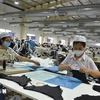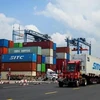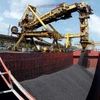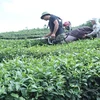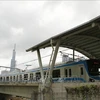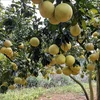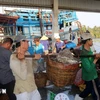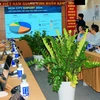After being re-established more than 20 years ago, with great efforts Kon Tum province has attained impressive and important socioeconomic achievements, particularly in poverty reduction.
To learn about its achievements as well as development orientations, Vietnam Business Forum Magazine has an interview with Nguyen Van Hung, Chairman of Kon Tum Provincial People’s Committee.
* Could you introduce the remarkable socioeconomic development achievements of Kon Tum province in the more than 20 years since its re-establishment?
Economically, the province has seen increasing annual economic growth. Annual economic growth was 9.15 percent in the 1992 - 1995 period, 9.85 percent in the 1996 - 2000 period, 11 percent in the 2001 - 2005 period, 14.51 percent in the 2005 - 2010 period, 13.89 percent in the 2011 - 2012 period, and estimated at 12.4 percent in 2013. State budget revenue has rapidly increased.
Agriculture and forestry has made progress. The production value expanded 3.28 percent a year in the 1992 - 1995 period, 10.7 percent in the 1996 -2000 period, 9.15 percent in the 2001 - 2005 period, 7.52 percent in the 2005 - 2010 period, 8.24 percent in the 2011 - 2012 period, and estimated at 6.78 percent in 2013. Apart from traditional crops and livestock, high-value industrial crops like rubber and coffee are actively developed.
The industrial sector posted an annual growth of 14.5 percent in the 1996-2000 period, 16.76 percent in the 2001 - 2005 period, 25.5 percent in the 2005 - 2010 period, 17.35 percent in the 2011 - 2012 period, and estimated at 15.88 percent in 2013. With sound policies, the industry has gradually and stably developed on the right track.
The trade and service sector saw a yearly growth of 6.8 percent a year in the 1996 - 2000 period, 11.18 percent in the 2001 - 2005 phase, 16.49 percent in the 2006 - 2010 period, and 31.64 percent in the 2011 - 2012 period.
Potentials in hydropower, minerals and forest land have attracted a lot of businesses and investors to the province. The infrastructure has been much invested and gradually met the demand of people and enterprises.
The quality of education and health care has been continuously improved. Poverty reduction has also been accelerated to better living conditions of the people. But in my opinion, the greatest achievement is the strong belief of the entire population in the province in the prospect of poverty elimination at the end of 2015.
* To bring into play its advantages in connection with the central region and the Central Highlands, to get out of poverty in 2015 and become a highlight in the Central Highlands, what programmes and groundbreaking actions will Kon Tum take?
To unlock potentials and make socioeconomic development breakthroughs, Kon Tum province issued a scheme for construction and development of flagship economic sectors and key products. Particularly, the province has developed five sectors into flagship sectors, including perennial crop planting; forest planting and care; agro-forestry production and processing; extractive industry; and electricity production, transmission and distribution. The scheme also specifies the development of the nine key products, including coffee; rubber and rubber products; cassava and cassava products; Ngoc Linh ginseng; vegetables; freshwater fish; pulp and paper; brick and tile; and electricity.
To date, 1,100ha of tea, vegetables, flowers and fruits with high economic value has been invested by businesses and 280ha are being cared by households and individuals. Three commercial salmon and sturgeon breeding projects are being carried out, in association with ecotourism development, and four cooperatives are culturing sturgeons. Baby sturgeons are also being exported to other localities. Enterprises also invested in 7.84 ha of ginseng nurseries and 169ha of Ngoc Linh ginseng.
Currently, Kon Tum is seeing new huge opportunities for development after the Government approved the development of construction plan of Mang Den ecological tourism zone, investment for National Road 24 and Ho Chi Minh Highway (Kon Tum - Gia Lai section).
In addition, the province has actively promoted external relations to lay the foundation for the formation of an economic corridor that connects surrounding provinces to the Bo Y International Border Gate Economic Zone like Ubon, Ratchathani and Sisaket provinces (Thailand), Champasak, Sekong and Attapeu provinces (Laos), and Central Highlands and central provinces (Vietnam).
In 2012, Kon Tum province proposed to the Government and the Ministry of Planning and Investment to organise the 8th meeting of Coordinating Committee of Development Triangle (Cambodia, Laos and Vietnam) Bo Y International Border Gate Economic Zone has been chosen to be one of eight border gate economic zones to be funded by the State Budget for development in the 2012-2015 period to become a driving force and the centre of the development triangle.
* As a part of Cambodia - Laos - Vietnam Development Triangle, do you have any proposals to step up connectivity and investment cooperation with other localities?
In the past time, in spite of achieving significant results, the Cambodia - Laos - Vietnam Development Triangle is a specially poor region. Underlying challenge to development is lax interconnectivity with interested regions, unsynchronised and degraded infrastructure, insufficient labour supply, especially high-level personnel, etc. To strengthen linkage and cooperation for investment in localities in the CLV Development Triangle, I think, we need to focus on seven issues as follows:
First, the centre of connectivity - the driving force for triangle development - will be the Indochina Junction where Vietnam, Laos and Cambodia share the borderline. Then, the centre will link to economic centres in Northeast Thailand (Ubon Ratchathani), Laos (Champasak) and Vietnam (provinces from the Central Highlands and the Southeast, Ho Chi Minh City, Nhon Hoi Economic Zone, Dung Dung Economic Zone, Chu Lai Open Economic Zone, Da Nang city). The province will open the border gate of Dak Coi (Kon Tum) - KonTuyNaek (Ratanakiri, Cambodia) to support the Bo Y (Kon Tum) - Phu Cua (Attapeu) border gate.
Second, building traffic corridors connecting regions to develop the economic corridor, routes to serve tourism, agriculture and industrial development, roads leading to border gates to support the development of CLV development triangle
Third, linking in agricultural development to create a commercial agriculture of large scale, concentration and high competitiveness; building up the brand names for some products of comparative advantages of the Development Triangle such as coffee, rubber, cocoa, pepper and cotton. A high-tech rubber processing centre is expected to te set up here.
Fourth, cooperating in human resource training.
Fifth, the governments of three countries need special mechanisms, policies and incentives for joint socioeconomic development in the Development Triangle like drawing external investment sources like ODA and FDI; apply common administrative mechanisms and procedures for goods transportation, travelling and capital mobility in the CLV Development Triangle.
Sixth, leaders of investment ministries, affected provinces of the three countries and the Steering Committee on Central Highlands should agree on coordinating mechanisms for affected localities, and
Seventh, coordinating in security and foreign affairs to strengthen peace, stability and development for the region and security and safety for investors and residents in Development Triangle.-VNA
To learn about its achievements as well as development orientations, Vietnam Business Forum Magazine has an interview with Nguyen Van Hung, Chairman of Kon Tum Provincial People’s Committee.
* Could you introduce the remarkable socioeconomic development achievements of Kon Tum province in the more than 20 years since its re-establishment?
Economically, the province has seen increasing annual economic growth. Annual economic growth was 9.15 percent in the 1992 - 1995 period, 9.85 percent in the 1996 - 2000 period, 11 percent in the 2001 - 2005 period, 14.51 percent in the 2005 - 2010 period, 13.89 percent in the 2011 - 2012 period, and estimated at 12.4 percent in 2013. State budget revenue has rapidly increased.
Agriculture and forestry has made progress. The production value expanded 3.28 percent a year in the 1992 - 1995 period, 10.7 percent in the 1996 -2000 period, 9.15 percent in the 2001 - 2005 period, 7.52 percent in the 2005 - 2010 period, 8.24 percent in the 2011 - 2012 period, and estimated at 6.78 percent in 2013. Apart from traditional crops and livestock, high-value industrial crops like rubber and coffee are actively developed.
The industrial sector posted an annual growth of 14.5 percent in the 1996-2000 period, 16.76 percent in the 2001 - 2005 period, 25.5 percent in the 2005 - 2010 period, 17.35 percent in the 2011 - 2012 period, and estimated at 15.88 percent in 2013. With sound policies, the industry has gradually and stably developed on the right track.
The trade and service sector saw a yearly growth of 6.8 percent a year in the 1996 - 2000 period, 11.18 percent in the 2001 - 2005 phase, 16.49 percent in the 2006 - 2010 period, and 31.64 percent in the 2011 - 2012 period.
Potentials in hydropower, minerals and forest land have attracted a lot of businesses and investors to the province. The infrastructure has been much invested and gradually met the demand of people and enterprises.
The quality of education and health care has been continuously improved. Poverty reduction has also been accelerated to better living conditions of the people. But in my opinion, the greatest achievement is the strong belief of the entire population in the province in the prospect of poverty elimination at the end of 2015.
* To bring into play its advantages in connection with the central region and the Central Highlands, to get out of poverty in 2015 and become a highlight in the Central Highlands, what programmes and groundbreaking actions will Kon Tum take?
To unlock potentials and make socioeconomic development breakthroughs, Kon Tum province issued a scheme for construction and development of flagship economic sectors and key products. Particularly, the province has developed five sectors into flagship sectors, including perennial crop planting; forest planting and care; agro-forestry production and processing; extractive industry; and electricity production, transmission and distribution. The scheme also specifies the development of the nine key products, including coffee; rubber and rubber products; cassava and cassava products; Ngoc Linh ginseng; vegetables; freshwater fish; pulp and paper; brick and tile; and electricity.
To date, 1,100ha of tea, vegetables, flowers and fruits with high economic value has been invested by businesses and 280ha are being cared by households and individuals. Three commercial salmon and sturgeon breeding projects are being carried out, in association with ecotourism development, and four cooperatives are culturing sturgeons. Baby sturgeons are also being exported to other localities. Enterprises also invested in 7.84 ha of ginseng nurseries and 169ha of Ngoc Linh ginseng.
Currently, Kon Tum is seeing new huge opportunities for development after the Government approved the development of construction plan of Mang Den ecological tourism zone, investment for National Road 24 and Ho Chi Minh Highway (Kon Tum - Gia Lai section).
In addition, the province has actively promoted external relations to lay the foundation for the formation of an economic corridor that connects surrounding provinces to the Bo Y International Border Gate Economic Zone like Ubon, Ratchathani and Sisaket provinces (Thailand), Champasak, Sekong and Attapeu provinces (Laos), and Central Highlands and central provinces (Vietnam).
In 2012, Kon Tum province proposed to the Government and the Ministry of Planning and Investment to organise the 8th meeting of Coordinating Committee of Development Triangle (Cambodia, Laos and Vietnam) Bo Y International Border Gate Economic Zone has been chosen to be one of eight border gate economic zones to be funded by the State Budget for development in the 2012-2015 period to become a driving force and the centre of the development triangle.
* As a part of Cambodia - Laos - Vietnam Development Triangle, do you have any proposals to step up connectivity and investment cooperation with other localities?
In the past time, in spite of achieving significant results, the Cambodia - Laos - Vietnam Development Triangle is a specially poor region. Underlying challenge to development is lax interconnectivity with interested regions, unsynchronised and degraded infrastructure, insufficient labour supply, especially high-level personnel, etc. To strengthen linkage and cooperation for investment in localities in the CLV Development Triangle, I think, we need to focus on seven issues as follows:
First, the centre of connectivity - the driving force for triangle development - will be the Indochina Junction where Vietnam, Laos and Cambodia share the borderline. Then, the centre will link to economic centres in Northeast Thailand (Ubon Ratchathani), Laos (Champasak) and Vietnam (provinces from the Central Highlands and the Southeast, Ho Chi Minh City, Nhon Hoi Economic Zone, Dung Dung Economic Zone, Chu Lai Open Economic Zone, Da Nang city). The province will open the border gate of Dak Coi (Kon Tum) - KonTuyNaek (Ratanakiri, Cambodia) to support the Bo Y (Kon Tum) - Phu Cua (Attapeu) border gate.
Second, building traffic corridors connecting regions to develop the economic corridor, routes to serve tourism, agriculture and industrial development, roads leading to border gates to support the development of CLV development triangle
Third, linking in agricultural development to create a commercial agriculture of large scale, concentration and high competitiveness; building up the brand names for some products of comparative advantages of the Development Triangle such as coffee, rubber, cocoa, pepper and cotton. A high-tech rubber processing centre is expected to te set up here.
Fourth, cooperating in human resource training.
Fifth, the governments of three countries need special mechanisms, policies and incentives for joint socioeconomic development in the Development Triangle like drawing external investment sources like ODA and FDI; apply common administrative mechanisms and procedures for goods transportation, travelling and capital mobility in the CLV Development Triangle.
Sixth, leaders of investment ministries, affected provinces of the three countries and the Steering Committee on Central Highlands should agree on coordinating mechanisms for affected localities, and
Seventh, coordinating in security and foreign affairs to strengthen peace, stability and development for the region and security and safety for investors and residents in Development Triangle.-VNA
